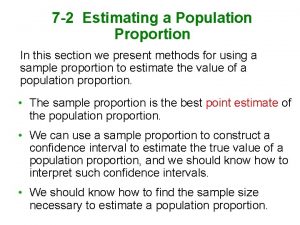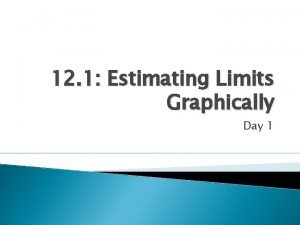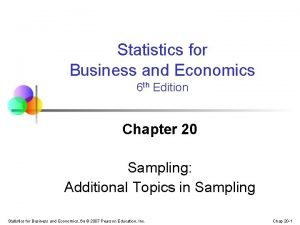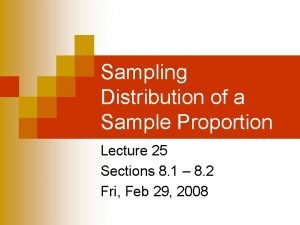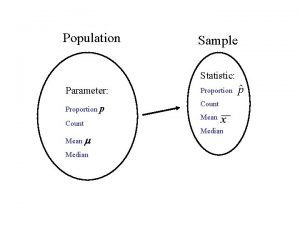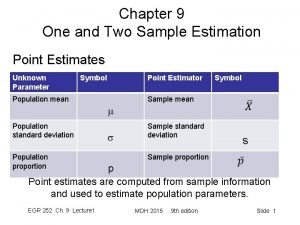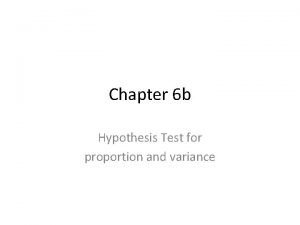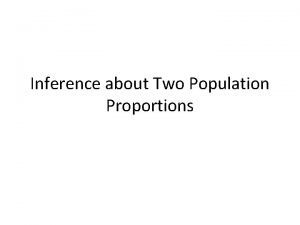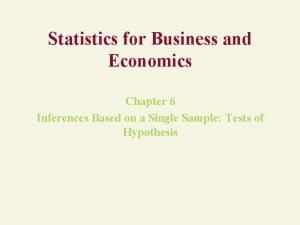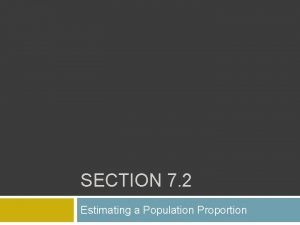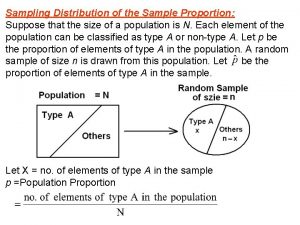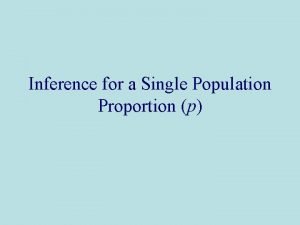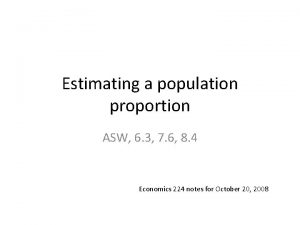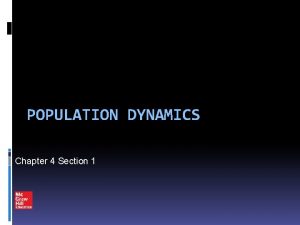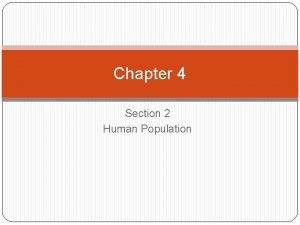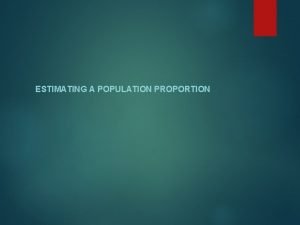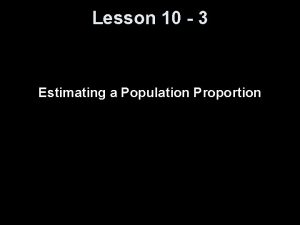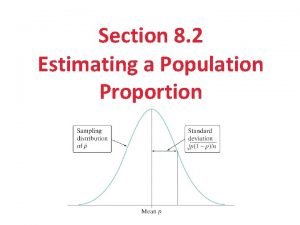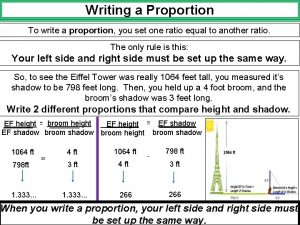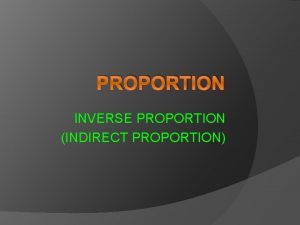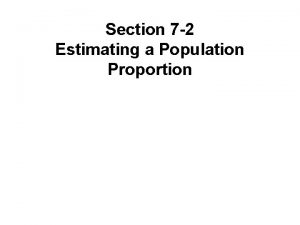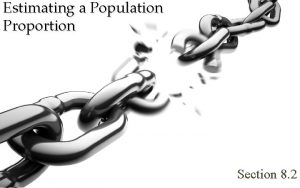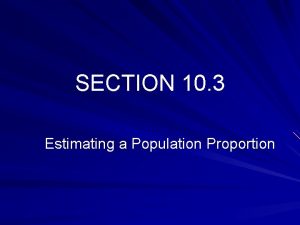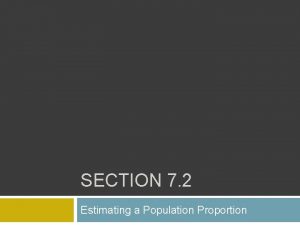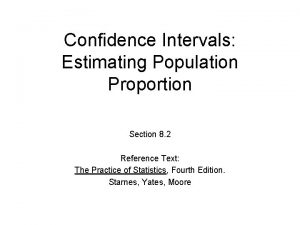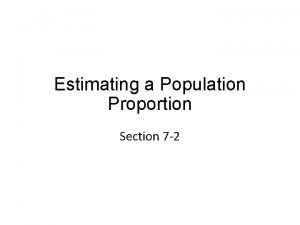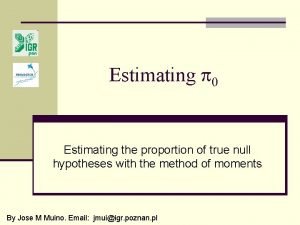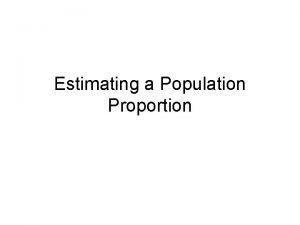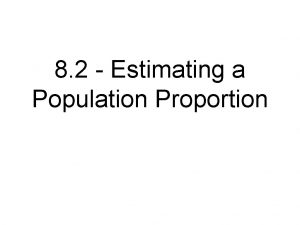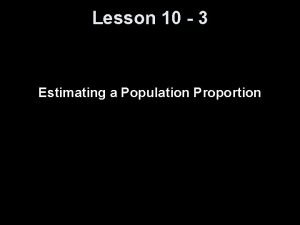SECTION 7 2 Estimating a Population Proportion Practice




















- Slides: 20

SECTION 7. 2 Estimating a Population Proportion

Practice Pg. 340 -341 #6 -8 (Finding Critical Values) #9 -11 (Expressing/Interpreting CI) #17 -20 (Finding Margin of Error)

Answers: Pg. 340 -341 #5 -8 (Finding Critical Values) 5. 2. 575 6. 2. 81 7. 1. 645 8. 2. 33 #9 -11 (Expressing/Interpreting CI) 9. 0. 350 +/- 0. 150 10. 0. 750 +/- 0. 030 11. 0. 483 +/- 0. 046 #17 -20 (Finding Margin of Error) 17. 0. 0304 18. 0. 0572 19. 0. 0325 20. 0. 0186

Topic 3 – Critical Example 1. 2. 3. Finding zα/2 for a 95% Confidence Level Find /2 Subtract the result from 1. Find the corresponding z score.

Topic 3 – Check Yo Self! Confidence Level 90% 95% 99% 0. 10 0. 05 0. 01 Critical Value, z /2 1. 645 1. 96 2. 575

Topic 4 – Margin of Error Definition Margin of Error: When data from a simple random sample are used to estimate a population proportion p, the margin of error, denoted by E, is the maximum likely difference (with probability 1 – , such as 0. 95) between the observed proportion and the true value of the population proportion p.

Topic 4 – Margin of Error Formula Important Notes Margin of Error for Proportions

Topic 4 – Check Your Self Assume that a sample is used to estimate a population proportion p. Find the margin of error, E, that corresponds to the given statistics and confidence level. Round the margin of error to three decimal places. 90% confidence, sample size is 500, 20% are successes. a) 99% confidence, sample size is 300, 25% are successes. b)

Topic 2 – Expressing A Confidence Interval 3 different ways to write a confidence interval

Topic 2 – Check Yo Self Assume that a sample is used to estimate a population proportion p. Find the margin of error, E, that corresponds to the given statistics and confidence level. Round the margin of error to three decimal places. 90% confidence, sample size is 500, 20% are successes. a) 99%***Now confidence, sample your size is answers 300, 25% are express successes. b) from before as an interval.

Topic 2 – Putting it All Together 1. 2. 3. 4. 5. How To Guide: Constructing a Confidence Interval Verify the sample is a simple, random sample and that the conditions for a binomial distribution are met. Find the critical value zα/2 Evaluate the margin of error. Find the values of the confidence interval limits. Round the resulting confidence interval limits to three decimal places.

Topic 2 – Example Constructing a Confidence Interval: Poll Results A poll of 1501 randomly selected U. S adults showed that 70% of the respondents believe in global warming. 1. Find the margin of error that corresponds to a 95% confidence interval. 2. Find the 95 th confidence interval estimate of the population proportion p. 3. Based on the results, can we safely conclude that the majority of adults believe in global warming?

Topic 3 – Determining Sample Size Objective Determine how large the sample should be in order to estimate the population proportion p. Requirements The sample must be a simple random sample of independent subjects. � When an estimate of is known: � When an estimate of is unknown:

Topic 3 – Determining Sample Size Important Note Round-off Rule for Determining Sample Size If the computed sample size n is not a whole number, round the value of n up to the next larger whole number.

Topic 3 – Determining Sample Size Example How Many Adults Use the Internet? An executive for E-Bay wants to determine the current percentage of U. S adults who now use the Internet. How many adults must be surveyed in order to be 95% confident that the sample percentage is in error by no more than three percentage points? � Use this result from a Pew Research Center poll: In 2006, 73% of U. S adults used the Internet. � Assume that we have no prior information suggesting a possible value of the proportion.

Topic 3 – Point Estimate and E Finding the Point Estimate and E from a Confidence Interval

Topic 3 – Point Estimate and E Example The article “High-Dose Nicotine Patch Therapy, ” by Dale Hurt includes the statement: “Of the 71 subjects, 70% were abstinent from smoking at 8 weeks (95% confidence interval, 58% to 81%). ” Use that statement to find the point estimate and margin of error E.

Practice Pg. 340 -341 #5 -8 (Finding Critical Values) #9 -11 (Expressing/Interpreting CI) #17 -20 (Finding Margin of Error) #21 -24 (Constructing Confidence Intervals) #25 -28 (Determining Sample Size) #31, 32 (Application Problems)

Answers: Pg. 340 -341 #5 -8 (Finding Critical Values) 5. 2. 575 6. 2. 81 7. 1. 645 8. 2. 33 #9 -11 (Expressing/Interpreting CI) 9. 0. 350 +/- 0. 150 10. 0. 750 +/- 0. 030 11. 0. 483 +/- 0. 046 #17 -20 (Finding Margin of Error) 17. 0. 0304 18. 0. 0572 19. 0. 0325 20. 0. 0186

Answers: Pg. 340 -341 #21 -24 (Constructing Confidence Intervals) 21. 0. 145 < p < 0. 255 22. 0. 182 < p < 0. 218 23. 0. 0674 < p < 0. 109 24. 0. 918 < p < 0. 936 #25 -28 (Determining Sample Size) 25. 475 26. 66, 30727. 1, 996 28. 486 #31, 32 (Application Problems) 31. a. ) 0. 505 b. ) 0. 496 < p<0. 514 c. ) no, proportion can easily be 0. 5 32. a. ) 0. 697 b. ) 0. 663 < p < 0. 731 c. ) Yes, p will be larger than 0. 5
 Confidence statement example
Confidence statement example Chapter 4 section 1 population dynamics
Chapter 4 section 1 population dynamics Section 1 population dynamics
Section 1 population dynamics Population ecology section 1 population dynamics
Population ecology section 1 population dynamics Section 1 population dynamics answer key
Section 1 population dynamics answer key 12-1 practice estimating limits graphically
12-1 practice estimating limits graphically What is proportional allocation
What is proportional allocation Sampling distribution of p hat
Sampling distribution of p hat Sm-2
Sm-2 Population proportion symbol
Population proportion symbol Hypothesis testing for population proportion
Hypothesis testing for population proportion Population proportion definition
Population proportion definition What is the ha
What is the ha Population proportion
Population proportion Sample proportion formula
Sample proportion formula Population proportion
Population proportion What is the population proportion
What is the population proportion Chapter 7 similarity
Chapter 7 similarity Study guide chapter 4 section 1 population dynamics
Study guide chapter 4 section 1 population dynamics Chapter 4 section 2 human population
Chapter 4 section 2 human population Section 1 population dynamics answer key
Section 1 population dynamics answer key
